Effective Strategies to Eliminate Centipedes from Your Home


Intro
Centipedes are often seen as unwelcome guests in our homes, creeping through dark corners and tight spaces. Understanding them is the first step in managing the discomfort they bring. This journey will cover essential information about centipedes, preventative measures to keep them away, and eco-friendly methods to eliminate them when necessary.
Understanding Pests
Definition of Pests
Pests, in a broad sense, are organisms that can cause harm or annoyance in human environments. Centipedes belong to the class Chilopoda, characterized by their elongated bodies and numerous legs. They are primarily nocturnal and feed on insects, making them effective at controlling certain pest populations. However, their presence in our homes can lead to unease and often requires intervention.
Importance of Pest Identification
Identifying pests is crucial. Knowing the specific type of pest allows for targeted strategies to manage them. Centipedes, specifically, can vary in size and coloration. Proper identification can help determine their habitat preferences and feeding behaviors, which aids in effective pest management.
Prevention Techniques
Home and Garden Preventative Measures
Preventing centipedes from entering your home begins with maintaining a clean and organized space. Here are some effective measures:
- Seal Cracks and Crevices: Inspect your home for any openings, especially around windows, doors, and the foundation. Use caulk or weather stripping to seal these gaps.
- Reduce Moisture: Centipedes thrive in damp environments. Fix any leaks and ensure proper drainage around your home. Use a dehumidifier in particularly humid areas.
- Clear Clutter: Remove debris and clutter both inside and outside your home. Wood piles, leaves, and other organic matter can provide hiding spots for centipedes.
Seasonal Prevention Tips
Understanding the seasons can further enhance your pest prevention strategy. During warmer months, centipedes may venture indoors in search of food and moisture. Here are some seasonal tips:
- Spring Cleaning: Deep clean your home as winter ends to eliminate potential nests and hiding spots.
- Summer Surveillance: Monitor for increased activity during hot months and reinforce your barriers against entry.
- Autumn Preparations: As the weather cools, centipedes may look for warmth. Be proactive in sealing up your home during this transition.
Eco-Friendly Pest Control Solutions
Overview of Sustainable Practices
The desire for effective pest control should not compromise environmental integrity. Sustainable practices focus on reducing environmental impact while managing centipede populations effectively. This includes using non-toxic sprays and baits that are safe for both humans and pets.
Natural Remedies and Their Effectiveness
Several natural remedies can deter centipedes without harmful chemicals:
- Diatomaceous Earth: Sprinkling food-grade diatomaceous earth in areas where centipedes are prevalent can help. It works by damaging their exoskeletons, leading to dehydration.
- Essential Oils: Oils like peppermint or cedar can act as natural repellents. Mixing a few drops with water and spraying in areas of activity may help deter them.
- Soap and Water Solution: A simple solution made from liquid soap and water can be effective. It works by suffocating the centipedes when sprayed directly on them.
Effective pest management is not just about elimination; it also involves understanding and adapting to the behaviors of the pests.
Managing centipedes in your home is about prevention and responsive actions. Understanding these strategies can provide you with the knowledge and tools to maintain a centipede-free environment.
Understanding Centipedes
Understanding centipedes is crucial for effective management of infestations in homes. By learning about their biology, behavior, and environmental requirements, homeowners can take proactive measures to prevent and eliminate these pests. Awareness of the creature's characteristics leads to informed solutions that are more likely to succeed.
Biology of Centipedes
Centipedes belong to the class Chilopoda, characterized by their elongated bodies and numerous legs. Each segment of a centipede typically has one pair of legs. This feature distinguishes them from millipedes, which have two pairs of legs per segment. Centipedes can vary in size, typically ranging from 1 inch to 12 inches in length. Their color can also differ, often appearing in shades of brown, red, or yellow.
Centipedes are predatory in nature. They capture small insects and pests, injecting venom with their specialized front legs. Understanding this biology is essential for controlling populations, as their predatory habits may impact other pest control efforts. The life cycle of centipedes includes several stages: egg, larva, and adult, with conditions such as humidity playing a critical role in their development.
Common Species Found in Homes
There are several species of centipedes that are commonly found in homes. The most prevalent include:
- House Centipede (Scutigera coleoptrata): Recognizable by its long, slender body and numerous legs, it can often be seen running quickly across floors.
- Geophilus spp.: Commonly found in gardens and soil, these centipedes can occasionally enter homes in search of moisture.
Identifying the specific species is important, as their behavior and habitat preferences may vary. For instance, while house centipedes prefer damp areas, other species may be more inclined to hiding in clutter. Knowing the exact types can help tailor prevention strategies effectively.
Behavioral Characteristics
Centipedes are nocturnal creatures. They prefer dark, damp environments, which makes basements or poorly lit corners of the house ideal habitats. They are swift runners, capable of moving quickly to evade threats. Their diet consists mainly of insects and other small arthropods, emphasizing their role in the local ecosystem.
When frightened, centipedes may secrete a foul-smelling liquid as a defense mechanism. They are solitary creatures, generally not seen in groups unless breeding. Understanding their behavior can significantly aid homeowners in developing strategies to deter their presence. For instance, eliminating hiding places and reducing moisture can effectively lower their chances of entering a home.
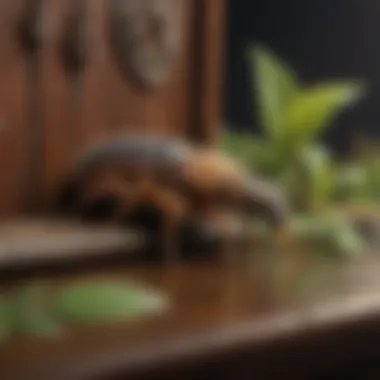

Recognizing a Centipede Infestation
Recognizing a centipede infestation is critical for homeowners aiming to maintain a safe and comfortable living environment. Centipedes are often elusive, hiding in cracks, crevices, and damp areas. Therefore, it is essential to know the signs and understand the implications of their presence in your home. Failing to address an infestation may lead to not only discomfort but also potential health concerns.
Signs of Infestation
Identifying the signs of a centipede infestation can save time and prevent escalation. Common indicators include:
- Visible Centipedes: Regular sightings, especially in areas like basements, bathrooms, and kitchens, signal a problem.
- Droppings: Small, dark pellets can indicate the presence of these pests.
- Shedding Skins: Centipedes molt as they grow, leaving behind their exoskeletons.
- Damage: Disturbed soil or small marks on walls may hint at their activity.
It is vital to conduct regular inspections, particularly in humid environments, as they are drawn to moisture. Prompt recognition allows for swift interventions, thus reducing the stress of handling a full-blown infestation.
Potential Health Risks
While centipedes are not known to transmit diseases, their bites can lead to discomfort. These bites are generally not life-threatening but may cause:
- Local Pain and Swelling: A bite can be similar to a bee sting and may require treatment.
- Allergic Reactions: Some individuals might experience more severe symptoms, necessitating medical attention.
- Psychological Effects: Frequent encounters with centipedes can create anxiety or unease within the home.
In summary, recognizing a centipede infestation early not only offers an opportunity for effective extermination but also minimizes health risks associated with their presence. Homeowners should be vigilant and proactive, creating a comfortable and safe living environment.
Environmental Factors Contributing to Infestations
Understanding environmental factors is essential in managing centipede infestations effectively. Centipedes thrive in certain habitats that provide them with the conditions necessary for survival. By recognizing and altering these conditions, homeowners can significantly reduce the likelihood of an infestation. This section will delve into the key environmental elements that contribute to centipede presence in homes: moisture and humidity, hiding places, and food sources.
Moisture and Humidity
Moisture levels in a home are a critical factor influencing centipede infestations. These organisms are moisture-seeking and prefer damp areas, such as bathrooms, basements, and kitchens. The environment created by excess humidity is conducive to their survival and reproduction. High moisture levels not only attract centipedes but also support their prey: insects like cockroaches and termites.
To mitigate moisture in the home:
- Fix leaks promptly to reduce dampness.
- Invest in dehumidifiers for areas with persistent humidity issues.
- Ensure proper ventilation in rooms prone to moisture.
By managing moisture, a homeowner can disrupt the centipede habitat and decrease the chances of infestation.
Hiding Places
Centipedes are nocturnal and spend most of their time in hiding to avoid predators and conserve moisture. They prefer dark, secluded spaces where they can rest during the day. Common hiding places include:
- Cracks and crevices in walls and floors.
- Underneath appliances and furniture.
- Inside cluttered areas, such as basements and garages.
To limit available hiding places:
- Declutter your home, keeping areas tidy and open.
- Seal gaps in walls, windows, and doors with caulk or weatherstripping.
- Use storage solutions that keep items off the ground and away from baseboards.
These proactive steps contribute to making a home less welcoming to centipedes.
Food Sources
Finally, understanding the food sources available to centipedes is vital. They are carnivorous and primarily feed on smaller arthropods. The presence of ants, spiders, and other insects creates a favorable environment for centipedes. Maintaining a clean home is essential for minimizing food sources.
To reduce food sources for centipedes:
- Vacuum regularly to remove crumbs and potential hiding insects.
- Seal food containers tightly to thwart pest attraction.
- Regularly check for other infestations, as controlling insect populations can also decrease centipede presence.
In summary, addressing these environmental factors contributes heavily to centipede management. Maintaining a drier home, minimizing hiding spots, and reducing food sources collectively enhance the defense against centipede infestations.
Preventing Centipedes from Entering Your Home
Preventing centipedes from penetrating your living space is crucial for maintaining a healthy and comfortable environment. These creatures thrive in damp and secluded areas, so it is important to create barriers that deter their entry. Effective preventive measures not only protect your home from centipedes but also enhance overall hygiene and diminish the likelihood of other pests. The investment in preventive strategies can save homeowners from the stress of dealing with potential infestations and the subsequent cleanup.
Home Maintenance Practices
One of the first lines of defense against centipedes is maintaining a clean and organized home. Regular cleaning routines can significantly reduce the chances of attracting centipedes. Vacuuming up dust, debris, and organic matter can deny them food sources that may support their existence. Areas such as basements, attics, and crawl spaces are often neglected yet can harbor moisture and potential prey for centipedes. Therefore, it is vital to routinely check and clean these spaces.
In addition, decluttering your home can have a profound effect. Centipedes prefer to hide in dark crevices or piles of clutter. By ensuring that items are stored neatly and kept off the floor, you create a less hospitable environment for these pests. Use storage bins or boxes, and prioritize keeping them sealed.
Sealing Entry Points
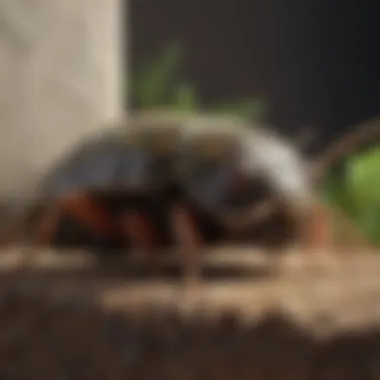
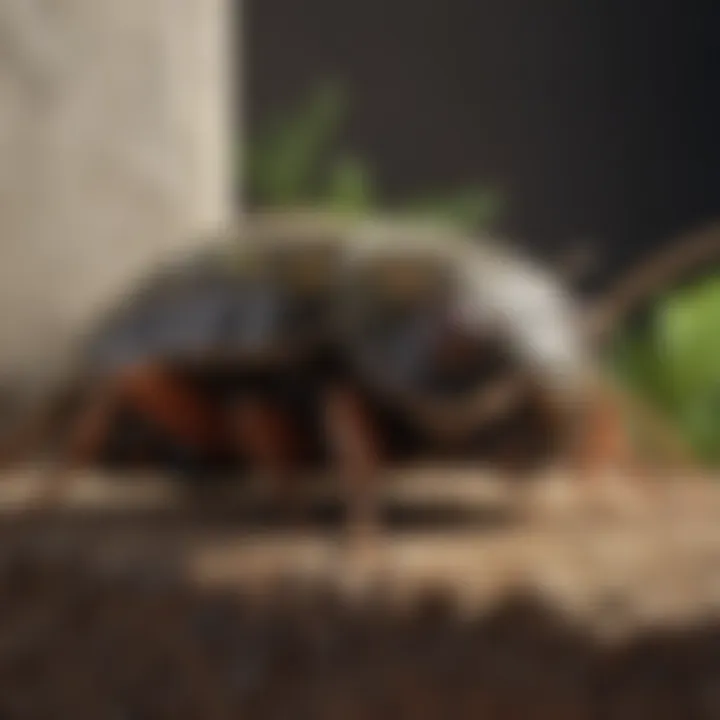
Another essential aspect of preventing centipedes is sealing potential entry points in your home. Inspect the exterior of your house for gaps, cracks, or holes in walls, windows, and doors. Small openings can become large entries for pests. Using caulk or weather stripping to seal these areas can make a significant difference. Pay special attention to places where pipes or wires enter the structure, as these are common entryways for pests.
Furthermore, ensuring that window screens are intact and windows are properly closed when not in use is necessary. Even a slight opening may allow centipedes to find their way inside. Maintaining tight seals around doors by installing door sweeps can also be an effective barrier against unwanted intruders.
Managing Landscaping and Outdoors
The landscaping around your home plays a significant role in centipede prevention. It is prudent to keep plant life trimmed and well-maintained. Overgrown vegetation can act as weedy havens for centipedes and other pests. Make sure not to allow mulch to sit too close to the foundations of your home; it can retain moisture and provide shelter.
Additionally, controlling moisture in the garden area is also critical. Consider installing drainage systems to redirect water away from your home, and avoid overwatering flower beds. Utilizing gravel or stones can further assist in maintaining a dry exterior.
By implementing these strategies, you can greatly reduce the likelihood of centipedes finding a way into your living space.
Using a combination of thorough home maintenance, effective sealing of entry points, and thoughtful landscaping will create a solid defense against these pests. In doing so, you foster a more secure environment that not only discourages centipedes but also enhances the overall well-being of your home.
Effective Removal Techniques
Effective removal techniques are crucial when addressing centipede infestations in the home. Centipedes can be bothersome pests, and knowing how to eliminate them efficiently can help maintain a comfortable living environment. This section explores various methods for removing these arthropods, emphasizing their specific advantages, potential downsides, and considerations for each method.
Manual Removal
Manual removal is one of the most straightforward methods for dealing with centipedes. This involves using a container or paper towel to capture and dispose of the centipede. While this method is effective for single or a few centipedes, it requires a degree of caution to avoid direct contact with these insects. Unlike other pests, centipedes can be fast and may bite if threatened.
Steps for Manual Removal:
- Equip yourself with a clear container.
- Approach the centipede slowly to avoid startling it.
- Carefully place the container over the centipede.
- Slide a piece of paper under the container to trap the centipede inside.
- Release the captured centipede outdoors, away from your home.
While manual removal can work well in small infestations, it is not always practical for larger populations. Moreover, this technique does not address the underlying causes of the infestation, meaning that without further action, centipedes could return.
Chemical Extermination Methods
Chemical extermination methods are often effective for larger infestations or where immediate results are desired. Various insecticides are available specifically for centipedes. These work by targeting the nervous system of the pest, leading to their demise. Choosing the right product is essential to ensure effectiveness while minimizing risks to humans and pets.
Factors to consider when using chemical methods:
- Safety: Always read the labels for safety instructions. Some chemicals can be harmful to pets and children.
- Types of Insecticides: Options range from sprays to granules. For indoor use, opt for targeted sprays that can penetrate cracks and crevices.
- Panel Application: Apply insecticides in areas where centipedes commonly hide, such as basements, bathrooms, or kitchen areas.
One drawback of chemical extermination is that it can lead to a reliance on these substances, and it does not address the root problem of why the centipedes entered the home initially. Furthermore, persistent chemicals may lead to resistance in some pest populations over time.
Natural Extermination Solutions
Natural extermination solutions are an attractive option for many homeowners seeking eco-friendly methods to deal with centipedes. These solutions typically include ingredients that are less harmful to the environment, pets, and human inhabitants.
Popular natural solutions include:
- Diatomaceous Earth: This powdery substance can be sprinkled in areas where centipedes are frequently seen. It is abrasive to their exoskeleton, resulting in dehydration and death.
- Essential Oils: Certain essential oils, like peppermint or tea tree oil, are known for their insect-repellent properties. Mixing oils with water can create a spray that effectively repels centipedes when applied in common hiding spots.
"Creating a balance between effective pest control and safety is crucial in choosing your removal strategy."
Natural methods often require more frequent application and may not be as instantaneous as chemical solutions. However, they offer a sustainable and less hazardous approach, making them particularly appealing for families with young children or pets.
In summary, effective removal techniques for centipedes encompass a range of options from manual and chemical methods to natural solutions. Each method has its advantages and drawbacks, so evaluating the specific needs of your situation is essential for successful pest management.
Utilizing Traps and Repellents
Utilizing traps and repellents is a critical part of managing the presence of centipedes in a home. These methods not only help in reducing the current population but also prevent future infestations. Traps provide a physical means to capture centipedes while repellents create a barrier that discourages their entry. For many homeowners, these solutions are practical and often more eco-friendly compared to chemical extermination methods, making them highly attractive options.
Types of Traps
There are several types of traps that can effectively capture centipedes. Understanding the characteristics of each type can help in making an informed decision.
- Sticky Traps: These traps consist of a sticky surface that entraps centipedes when they walk across. They are easy to set up and can be placed discreetly in corners or under furniture.
- Mechanical Traps: This type includes devices that use a spring or a mechanism to trap centipedes. They are reusable and can provide a more efficient means of capture.
- Baited Traps: These traps use food or bait to attract centipedes. Once the centipede is lured in, it becomes trapped. However, this may attract other pests as well, which is a factor to consider.
Setting traps in areas where centipedes are likely to frequent, such as dark corners or damp areas, increases the chances of catching them. It is important to regularly check the traps and dispose of any captured pests properly.
Effective Repellent Options
Repellents can help deter centipedes from entering your home. Here are some effective options:
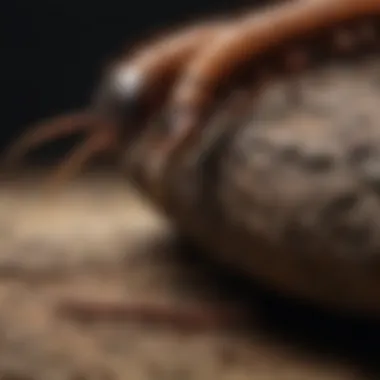
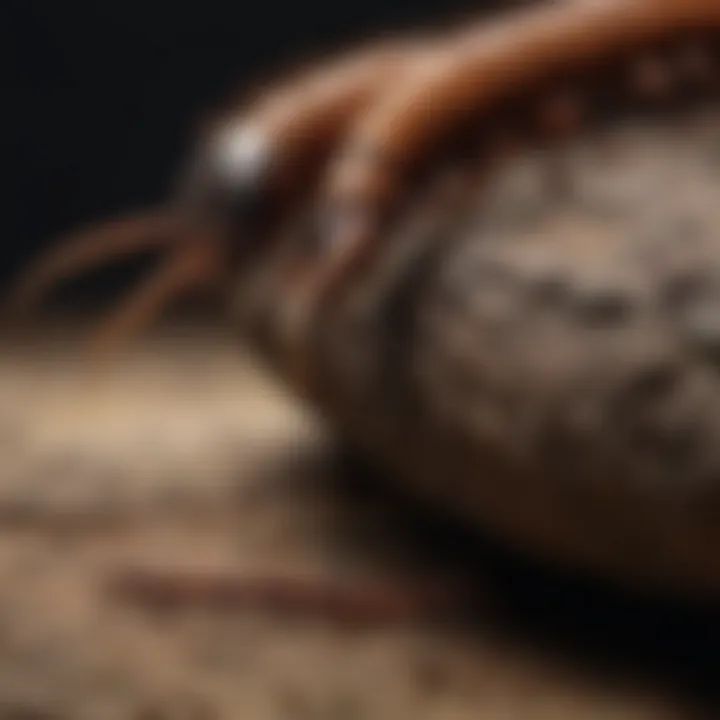
- Essential Oils: Oils like peppermint, tea tree, or eucalyptus can act as natural repellents. Mixing these oils with water in a spray bottle and applying them around entry points can create an inhospitable environment for centipedes.
- Diatomaceous Earth: This natural powder can be sprinkled around areas where centipedes are spotted. It works by damaging the soft outer skeleton of the insect, which causes them to dehydrate and die.
- Commercial Repellents: Many products available in stores offer effective repellent properties specifically against centipedes. Read the labels to ensure they are designed for such pests.
Keeping in mind that the effectiveness of repellents may vary, it is advisable to combine several strategies for optimal results. Regularly reapplying repellents is also crucial to maintain their effectiveness.
"The combination of traps and repellents can significantly diminish centipede populations and minimize the risk of their return in the future."
By utilizing these methods, homeowners can manage centipede infestations more effectively and create a less welcoming environment for these pests.
When to Seek Professional Help
Deciding when to call in professionals for centipede control can be a confusing task for many homeowners. Understanding the right moment to seek assistance can not only save time but also prevent health issues and damage to your property. In some cases, the use of DIY methods may not yield sufficient results. Thus, evaluating the severity of the infestation is crucial.
Assessing the Severity of Infestation
When you suspect centipedes in your home, the first step is to evaluate how significant the problem is. Observing a few centipedes occasionally might not indicate a severe infestation. However, here are some signs that you should look for to gauge the severity:
- Frequent sightings: If you notice centipedes daily, this signals a larger population.
- Visible nests or egg cases: Finding their nests indicates reproduction.
- Presence of other pests: Centipedes feed on insects. If you have other pests, it suggests a conducive environment for centipedes.
- Damage to property: Observing signs of wear on materials suggests a persistent problem.
In these cases, contacting a professional exterminator could lead to a more effective resolution than attempting to manage the issue alone.
Benefits of Professional Extermination Services
Engaging professional services can provide multiple advantages when dealing with a centipede infestation. Here are key benefits:
- Expertise: Professionals have the knowledge and experience to identify centipede species and their nesting habits.
- Efficient methods: They use advanced techniques that may not be available to homeowners.
- Long-term solutions: Professionals typically offer solutions that prevent future infestations, not just immediate extermination.
- Safety: They safely handle and apply chemicals and treatments, minimizing risks to households and pets.
- Time-saving: Hiring experts can save you time and hassle compared to trial-and-error methods.
"When dealing with pest infestations, sometimes the best approach is to let experts handle it. Their insight can often lead to a more thorough solution."
In summary, monitoring the level of centipede activity and understanding the options available can make all the difference. When in doubt, reaching out to professional services can ensure effective and comprehensive management of the issue.
Long-Term Management Strategies
Establishing long-term management strategies is crucial in the battle against centipedes. While initial extermination may eliminate these pests temporarily, sustained efforts focus on prevention, ensuring that a centipede re-infestation does not occur. Homeowners often overlook this aspect, but proactive management is essential in maintaining a comfortable living environment.
The main elements of a long-term strategy include regular monitoring, environmental adjustments, and habits that reduce favorable conditions for centipedes. Adopting these practices can lead not only to fewer encounters with these pests but also to a more significant understanding of their behavior and needs.
A structured approach aids homeowners in identifying potential risks within their household. This foresight can significantly alleviate distress related to pest control, allowing everyone in the household to feel secure.
"Preventative measures are the first line of defense against future infestations."
This sentiment underscores the importance of being vigilant and adaptive in your strategy. Here are two key components to consider:
Regular Maintenance and Monitoring
Regular maintenance and vigilance are foundational in long-term management. Implementing periodic housekeeping routines can help identify areas where centipedes might thrive. This includes:
- Frequent Cleaning: Maintaining a clean living space minimizes shelter and food sources for centipedes. Regularly vacuuming corners and crevices can reduce their chances of staying unnoticed.
- Inspecting Entry Points: Routinely check for cracks in walls or gaps in windows and doors.
- Monitoring Humidity Levels: Centipedes thrive in moist environments. Use dehumidifiers to monitor and maintain necessary humidity levels in basements and crawl spaces.
Tracking observations to identify patterns in sightings or increases can aid in anticipating possible outbreaks. This practice will serve as an effective tool in your management arsenal.
Environmental Adjustments
Making environmental adjustments can significantly contribute to long-term prevention. Key areas to focus on include:
- Reduce Moisture: Fixing leaks in pipes, roofs, or foundations will eliminate prime habitats.
- Landscaping Choices: Opt for xeriscaping or low-water plants. Keeping mulch and soil a few inches from the base of your home discourages moisture retention.
- Clear Debris: Regularly clearing leaves or debris from around the home reduces hiding spots.
The aim is to create an environment less hospitable to centipedes. Over time, these quick adjustments can contribute significantly to a decrease in sightings, allowing homeowners to enjoy a more peaceful and pest-free residence.
Implementing these strategies requires commitment but pays off by providing lasting solutions to pest control issues. Homeowners should make these practices a regular part of their routine, ensuring a comfortable living space for all.
Culmination
The management of centipede infestations is crucial for maintaining a comfortable living environment. This article has covered various aspects of dealing with these pests, from understanding their biology and behavior to effective removal techniques and long-term management strategies.
Coherent strategies to eliminate centipedes can significantly reduce their presence in homes. Regular maintenance and monitoring are essential to prevent their entry and establish an unfriendly atmosphere for them.
In addition to practical solutions, emphasis has been put on sustainable and environmentally sound approaches. Many homeowners may prefer these methods due to health consideratins, especially if young children or pets are around.
By utilizing both manual removal and chemical or natural extermination methods, you can effectively tackle any infestation. Moreover, understanding the factors that contribute to centipede presence, such as moisture and hiding spots, can give homeowners an advantage.
It is also stated that seeking professional help is a valid option when infestations become challenging to manage. Professionals can provide expert solutions that may not be known to the average homeowner. However, for many, understanding how to approach the issue themselves is beneficial and empowering.
In summary, a proactive approach to centipede management not only addresses immediate concerns but also fosters an environment less conducive to future infestations. Through education and diligent practices, homeowners can achieve lasting control over centipedes and maintain a peaceful living space.
"Understanding and management are key to mitigating the impact of centipedes in your home."



